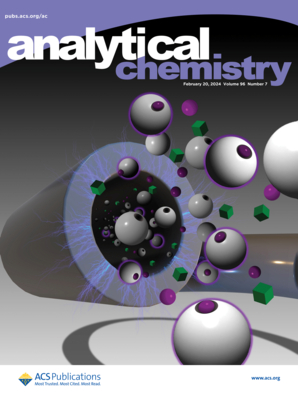脉冲电场消融下单个胰腺癌细胞的活性氧和氮释放:浓度和动力学。
IF 6.7
1区 化学
Q1 CHEMISTRY, ANALYTICAL
引用次数: 0
摘要
胰腺癌以其极高的致死率而闻名,通常在晚期才被诊断出来,只有少数患者有资格进行手术切除。脉冲电场消融(PEF)是临床上治疗局部晚期胰腺癌的一种消融技术,它通过破坏细胞氧化还原平衡,导致活性氧(ROS)和活性氮(RNS)的过量产生,从而导致肿瘤细胞死亡。原位监测PEF消融下胰腺癌细胞ROS/RNS水平的动态变化,对于了解其治疗胰腺癌的机制具有重要意义。本研究通过将PANC-1细胞培养在刚度为4.0 kPa的聚丙烯酰胺凝胶上,构建胰腺癌细胞体外模型,模拟胰腺癌晚期的力学微环境。建立理论模型,模拟PEF消融用于胰腺癌临床治疗的电场强度。将这些电场强度的PEF消融作用于体外胰腺癌细胞模型后,我们利用扫描电化学显微镜(SECM)原位监测了PANC-1细胞中过氧化氢(H2O2)和一氧化氮(NO)的动态释放过程。通过对SECM结果的定量分析,我们发现PEF消融超过1.5 kV cm-1的电场强度使细胞在初始5min内出现周期性爆发的H2O2和NO外排,治疗后6min内恢复到初始值,而线粒体功能障碍持续存在。它证明了电场强度对破坏细胞氧化还原平衡的长期影响,为电消融下电场强度依赖性胰腺癌氧化还原失衡的机制提供了有价值的见解。本文章由计算机程序翻译,如有差异,请以英文原文为准。
Reactive Oxygen and Nitrogen Species Release of Single Pancreatic Cancer Cells Subjected to Pulsed Electric Field Ablation: Concentration and Dynamics.
Pancreatic cancer, recognized for its extreme lethality, is normally diagnosed at an advanced stage, leaving only a minority of patients eligible for surgical resection. Pulsed electric field (PEF) ablation, an ablative technique for clinical treatment of locally advanced pancreatic cancer, causes tumor cell death by disrupting cellular redox balance, resulting in the overproduction of reactive oxygen species (ROS) and reactive nitrogen species (RNS). In situ monitoring of the dynamic changes in ROS/RNS levels of pancreatic cancer cells under PEF ablation is important for understanding its mechanism for pancreatic cancer treatment. Here, we constructed an in vitro pancreatic cancer cell model via culturing PANC-1 cells on polyacrylamide gels with a stiffness of 4.0 kPa to simulate the mechanical microenvironment of advanced pancreatic cancer stage. We then established a theoretical model and simulated the electric field strengths of PEF ablation used for the clinical treatment of pancreatic cancer. After applying PEF ablation with these electric field strengths on the in vitro pancreatic cancer cell model, we in situ monitored the dynamic releasing processes of hydrogen peroxide (H2O2) and nitric oxide (NO) from PANC-1 cells by employing scanning electrochemical microscopy (SECM). Through quantitative analysis of SECM results, we found that the electric field strengths of PEF ablation over 1.5 kV cm-1 caused cells to exhibit periodic bursts of H2O2 and NO effluxes during the initial 5 min and then reduced to their initial values within 6 min after treatment, while mitochondrial dysfunction persisted. It demonstrates a prolonged impact of electric field strength on disrupting cellular redox balance, offering valuable insights into the mechanism of electric field strength-dependent redox imbalance of pancreatic cancer under electric ablation.
求助全文
通过发布文献求助,成功后即可免费获取论文全文。
去求助
来源期刊

Analytical Chemistry
化学-分析化学
CiteScore
12.10
自引率
12.20%
发文量
1949
审稿时长
1.4 months
期刊介绍:
Analytical Chemistry, a peer-reviewed research journal, focuses on disseminating new and original knowledge across all branches of analytical chemistry. Fundamental articles may explore general principles of chemical measurement science and need not directly address existing or potential analytical methodology. They can be entirely theoretical or report experimental results. Contributions may cover various phases of analytical operations, including sampling, bioanalysis, electrochemistry, mass spectrometry, microscale and nanoscale systems, environmental analysis, separations, spectroscopy, chemical reactions and selectivity, instrumentation, imaging, surface analysis, and data processing. Papers discussing known analytical methods should present a significant, original application of the method, a notable improvement, or results on an important analyte.
 求助内容:
求助内容: 应助结果提醒方式:
应助结果提醒方式:


